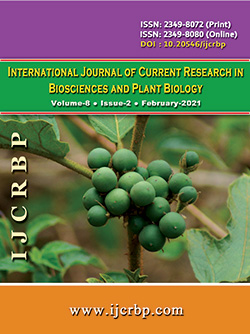 |
Online ISSN : 2349-8080 Issues : 12 per year Publisher : Excellent Publishers Email : editorinchiefijcrbp@gmail.com |
2The laboratory of Environmental Management and Plant Production, Department of Plant Biology, Faculty of Science,University of Yaoundé I, PO Box 812, Yaoundé-Cameroon
Anthracnose and Fusariose of beans caused by Colletotrichum lindemuthianum and Fusarium solani respectively are two dreaded diseases that can lead to yield losses of 30 to 100% in the field. The present study was carried out to evaluate the antifungal activities of seed extracts of Anonidium mannii (Annonaceae) on the in vitro growth of C. lindemuthianum and F. solani. Extracts of A. mannii seeds obtained from acetone, water and methanol solvents, were used for phytochemical screening and for the preparation of solutions with concentrations of 12.5, 25 and 50 µl/ml. To evaluate radial growth, explants of 0.7 cm diameter each were obtained from two strains of C. lindemuthianum and two strains of F. solani. They were placed each at the centre of sterile Petri dishes containing the PDA medium supplemented with the different concentrations of extracts and incubated at 23°C for 6 days. The results of the phytochemical screening revealed the presence of alkaloids, phenols, saponins in the A. mannii seed extracts and this depended on the solvent used. The minimum inhibitory concentrations (MIC50 and MIC90) were also calculated. At a concentration of 50µl/ml each, acetone extract inhibited the growth of strain 2 of C. lindemuthianum (2.33 cm) more than the methanol extract (3.26 cm) in six days of incubation. Similarly, the growth of strain 2 of F. solani was strongly inhibited by methanol extract (1.98 cm). The MIC50 of the aqueous extract gave 27.38 µl/ml with F. solani and 32.24 µl/ml for the acetone extract with C. lindemuthianum. Due to their antifungal power, after purification with bioactive compounds, the aqueous, acetone and methanol extracts revealed by the phytochemical screening could be used as synthetic fungicides for the control of anthracnose and fusariose of common bean.
